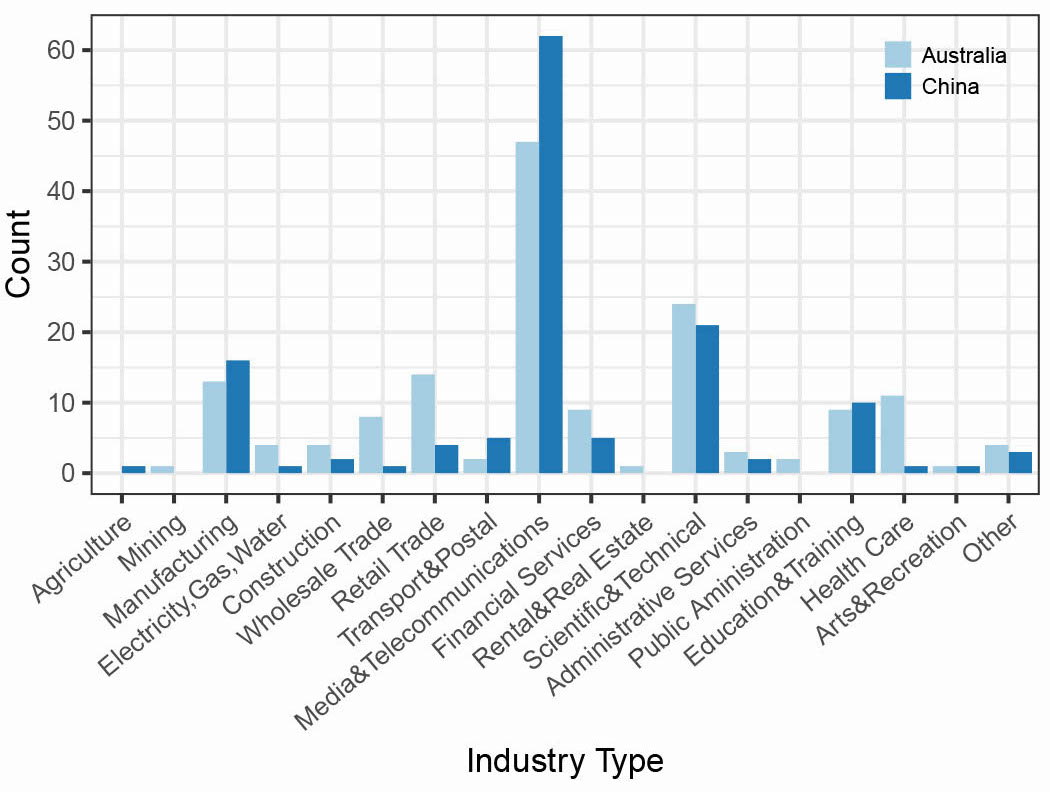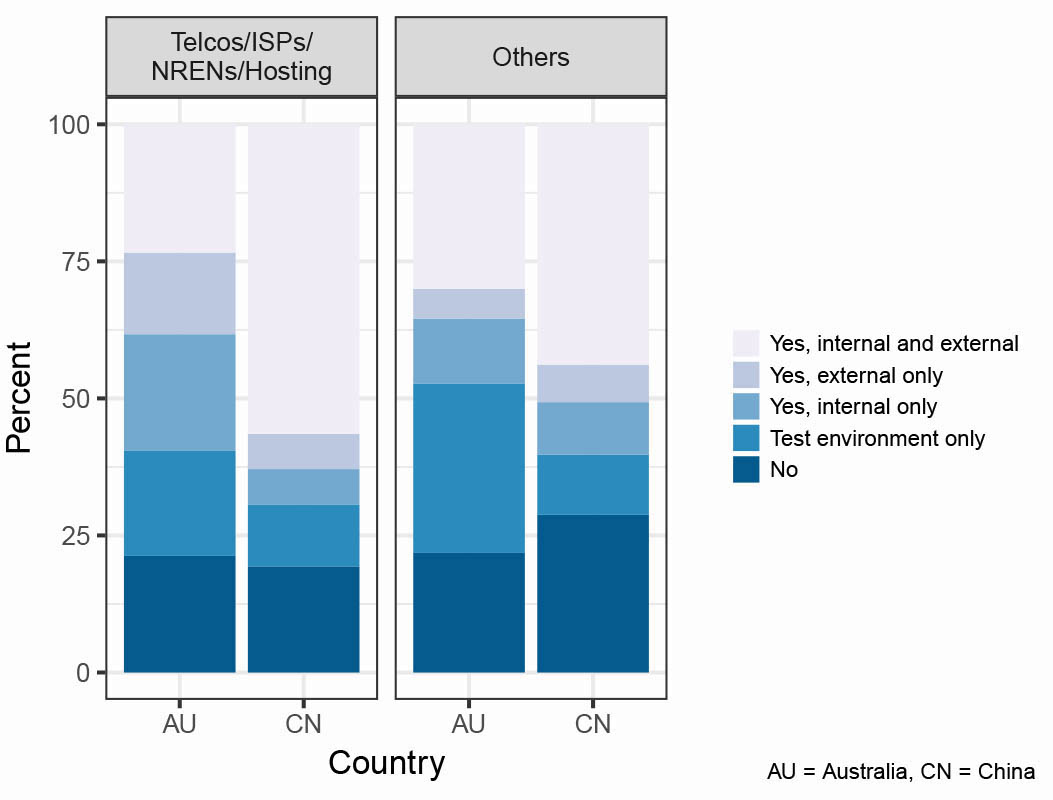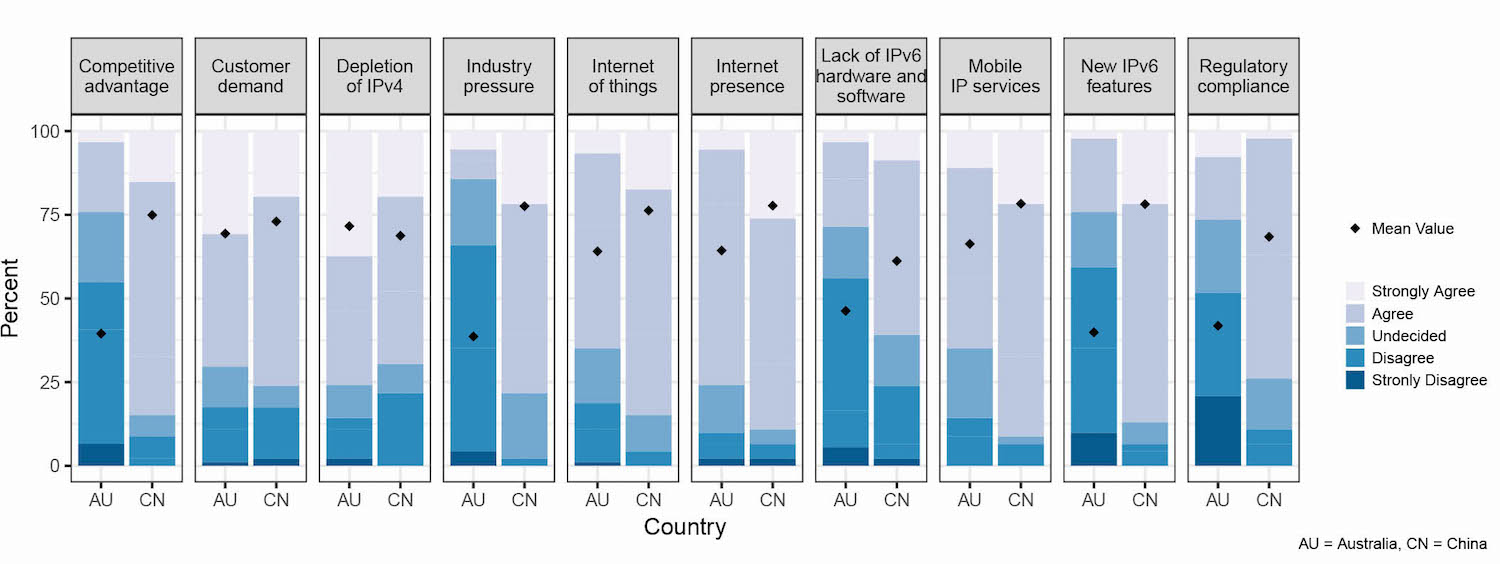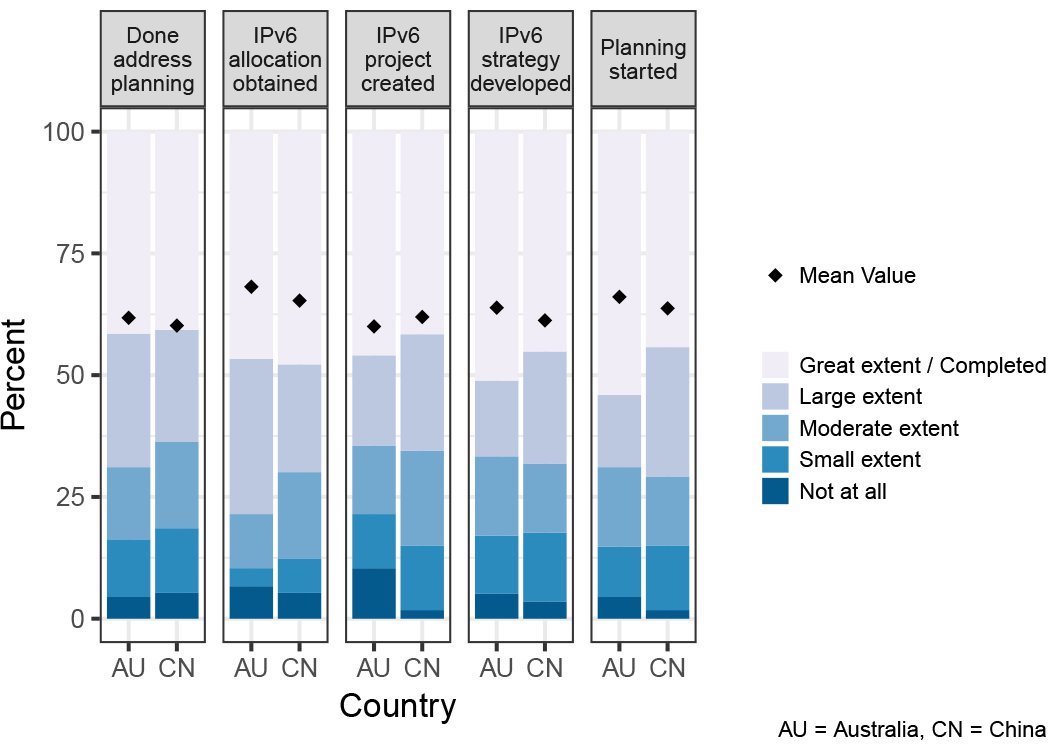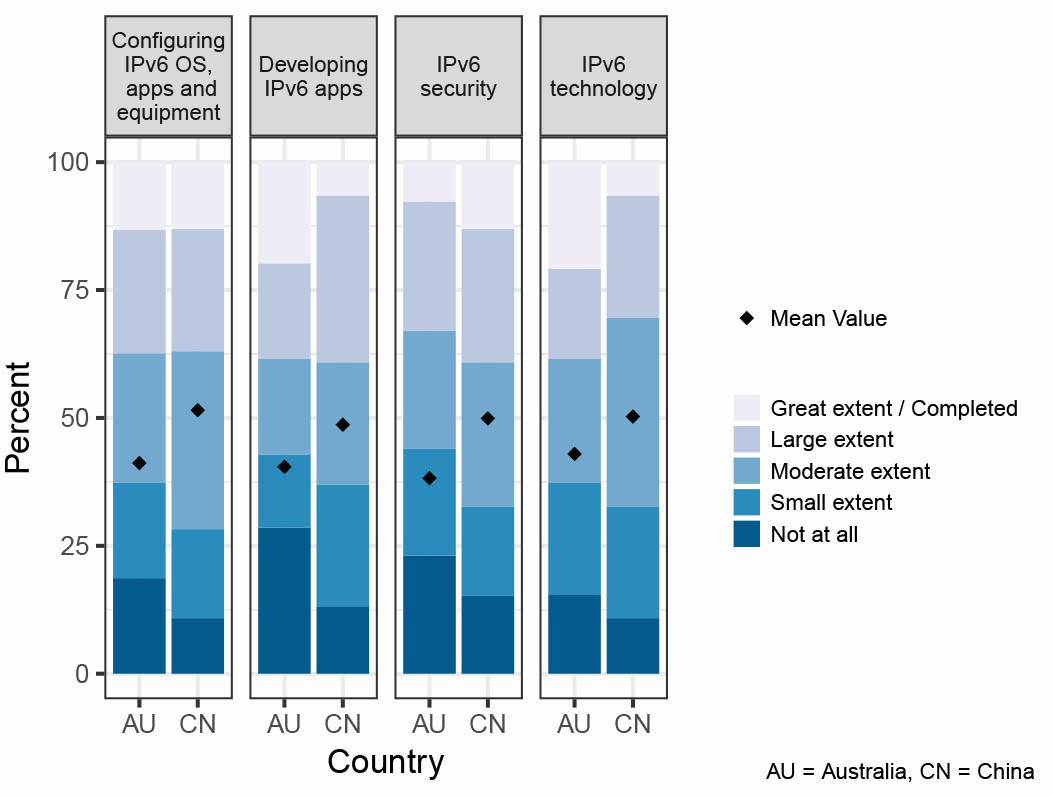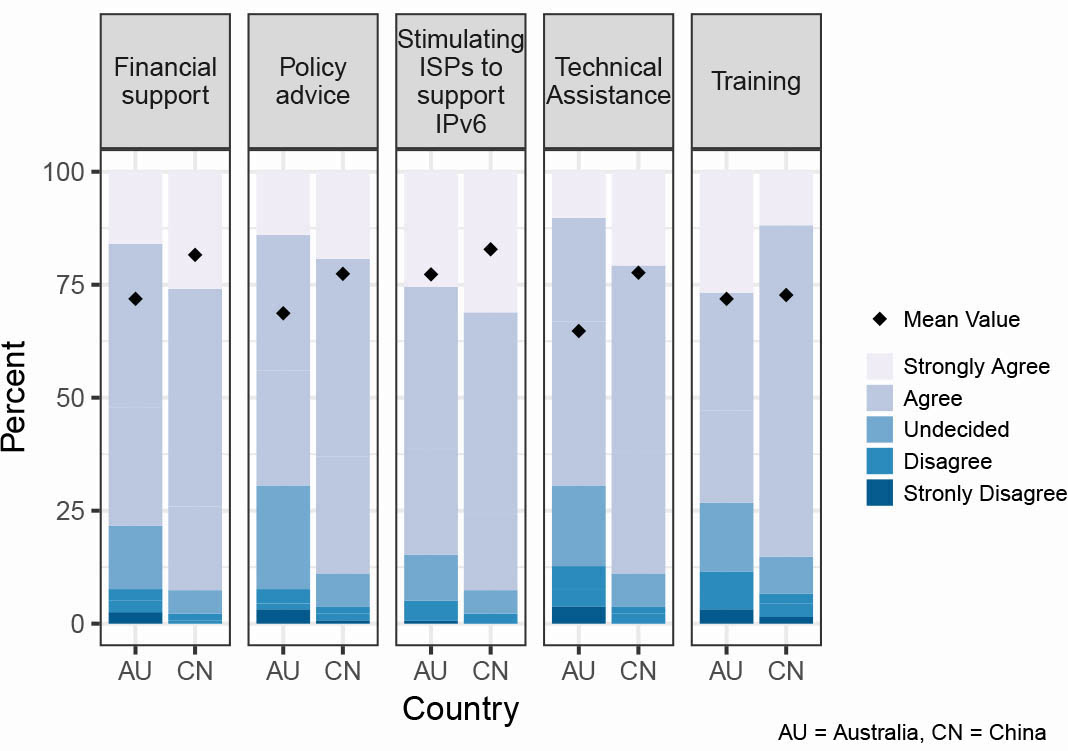
After many years of little progress, IPv6 deployment has grown significantly since 2012 in a number of developed economies, although growth has been very unequal.
According to Google’s IPv6 statistics and APNIC’s IPv6 statistics, the fraction of users that use IPv6 in a number of developed countries, such as the USA, Germany, Japan and Norway, was well over 5% at the beginning of 2016. In contrast, the fraction of users that use IPv6 in Australia or China was less than 5%. At the beginning of 2016, IPv6 deployment in Australia and China lagged significantly behind the leading countries.
In this research, my colleague Xuequn (Alex) Wang and I focussed on Australia and China, since not many details were known about the state of IPv6-readiness of these two countries in early 2016. Existing published surveys were either several years old, not very detailed, or were done on a global scale, with very few participants from Australia or China.
Furthermore, while Australia and China had similarly low IPv6 deployment, they are very different economies. China is a large and still developing economy with a population much larger than its number of IPv4 addresses, while Australia is a small, developed country with a much larger number of IPv4 addresses per capita than China. We expected that this would lead to interesting differences in the survey results.
This post summarizes some of the key findings of the study. More results are available on our Surveying the State of IPv6 Deployment in Australia and China web page.
Respondents
We conducted surveys among organizations in Australia and China. Between June and August 2016 we used survey companies to reach people from a broad background and also advertised the survey to APNIC Members, the AUSNOG mailing list, and the CNNIC mailing list. We used various ways to recruit participants, with the aim of getting a more diverse sample. The survey employed several screening questions to select only participants that had knowledge about IPv6 in their organizations.
For each country, the similarities between responses were checked to detect potential data records from the same organizations. The details of the pre-processing are described on our Surveying the State of IPv6 Deployment in Australia and China web page. After pre-processing, we were left with 292 responses: 157 from Australia and 135 from China.
The following figure shows the number of respondents in the two countries, grouped by industry type (ANZSIC classification).
The largest category is organizations from the media and telecommunications industry. This is expected because firstly, APNIC Members are biased towards this industry, and secondly, the screening question used by the market research companies required participants to know about IPv6, which also creates a bias towards this industry. Nevertheless, only one-third of Australian organizations and slightly over 40% of Chinese organizations fall into this category. The rest come from a large variety of different industries. In terms of organization size, the size of the customer base and number of IT staff, our survey also captured a wide variety of organizations.
Around 75% of our participants identified themselves as CIOs, top-level managers or mid-level managers, while 25% classified themselves as low-level managers and IT administrators/technicians. Over 90% of participants said that their decision-making authority with regard to networking infrastructure was final or that they have significant decision-making influence.
Deployment status
The following figure shows the breakdown of IPv6 deployment in Australian (AU) and Chinese (CN) organizations. It differentiates between Media and Telecommunication Organizations (MTOs), such as Telcos, ISPs, National Research and Education Networks (NRENs) and hosting providers, and other organizations (Others). Irrespective of country and organization type, only less than 25% of organizations have no IPv6 deployment at all. However, the percentage that has not deployed IPv6 at all or only in a test environment is still around 50% for Others and 35–50% for MTOs. MTOs appear to be further ahead with full/external IPv6 deployment in both countries, but in the case of Australia, the difference is marginal and even for China, the difference is not statistically significant. China is significantly ahead of Australia for Others, but even more so with regard to MTOs — more than 50% of Chinese organizations have full IPv6 deployment whereas only 20% of Australian organizations have full IPv6 deployment.
Of the 20–25% of organizations that have no IPv6 deployment, roughly two-thirds are not planning an IPv6 deployment. In China (where 61% of organizations have not deployed IPv6), this is mainly because decision-makers are aware of IPv6, but there are no plans to adopt it. However, in Australia, in 18% of the organizations that have not deployed IPv6 yet, the decision-makers are not even aware of IPv6. Among the one-third of organizations that are planning to deploy IPv6, in most of them, decision-makers are thinking about or are planning the deployment, but no formal plans for IPv6 deployment have been developed.
Production problems
The following figure shows the responses to the question of what the problems are with IPv6 in production. “Lack of investment money” is viewed as the smallest problem, with the biggest problem being the “Lack of training of staff”. Consistent with the higher deployment of IPv6 in China, the “Business case”, “Convincing decision-makers” and “Lack of demand” appear to be smaller problems in China than in Australia, yet only for demand is the difference statistically significant. Technical problems are seen as more of an issue in China, possibly because Chinese organizations are further ahead in IPv6 deployment and have had more opportunities to experience technical problems.
Urgency
Of the organizations that have not yet deployed IPv6 (but are planning to deploy it) and those that have not yet fully deployed IPv6 (not deployed in internal networks and Internet-facing services), 51% of Australian organizations and Chinese organizations view a transition to IPv6 as only moderately urgent or not urgent. About 39% of Australian organizations think the transition is fairly urgent to very urgent, and 10% view it as extremely urgent. In China, 46% think the transition is fairly urgent to very urgent, and 3% view it as extremely urgent.
The following figure looks into the factors determining the urgency to transition to IPv6. The most important factors across both countries are the “Depletion of the IPv4 space” and “Customer demand”; “Regulatory compliance” and “Lack of IPv6 hardware and software” are the least important factors. There is a huge difference for the factors “Competitive advantage”, “Industry pressure” and “IPv6 features” — these are seen as important for the urgency of the transition in China, but viewed as rather unimportant in Australia. Furthermore, differences for “Internet presence”, “Internet of Things”, “Regulatory Compliance” and “Lack of IPv6 hardware and software” are also significant.
Preparedness
We now look at the preparedness of organizations that have not deployed IPv6 yet but are planning to deploy it, and those that have not fully deployed IPv6 yet (that is, those that have not deployed IPv6 in internal networks and Internet-facing services). The questions focussed on the four areas of planning, policy development, state of assessment, and training, but we show only the results for planning and training here.
The following figure shows the status of planning for IPv6 in various areas. The category in which most organizations have made progress is (somewhat unsurprisingly) “IPv6 allocation obtained”, which is usually the first step. Differences between Australia and China are relatively small in most categories and are not significant.
While planning is well under way in most organizations, training is the area that is least advanced.
The next figure shows the state of IPv6 training provided. There is not much difference between the different training areas. China is consistently ahead in all categories, most noticeably in IPv6 security. When compared with the other preparedness areas, training is the least advanced.
How to speed up transition
We asked all participants which services could be offered by registrars or government agencies to help speed up the transition. The following figure shows the results.
Most respondents agreed or strongly agreed with all the categories, with the highest level of agreement for “Stimulating ISPs to support IPv6”. The four leftmost categories in the figure show significant stronger agreement from Chinese organizations.
We also asked our participants the open-ended question what else could be done to speed up the transition. The answers are summarized in a technical report available on our Surveying the State of IPv6 Deployment in Australia and China web page.
Stronger business case for IPv6 in China
Our survey results show that deployment of IPv6 has significantly advanced in Australia and China in recent years, but deployment in Australia still lags deployment in China.
Nevertheless, there is still a significant portion of organizations that has not deployed IPv6 yet and also has no plans to deploy it in the next one or two years.
Consistent with the higher deployment of IPv6, based on our respondents, there is more demand for IPv6 and thus a stronger business case for IPv6 in China.
Despite the progress, most respondents in both countries agree that further initiatives by Registries or government agencies are needed to speed up the transition, the most important being the stimulation of ISPs to support IPv6.
Acknowledgements
This work was supported by the inaugural APNIC Internet Operations Research Grant 2015, managed by ISIF Asia. The technical report about the grant implementation [1.2 MB] is available for download.
Sebastian Zander is a lecturer and Academic Chair for the Cyber Forensics and Information Security Major in the School of Engineering and Information Technology, Murdoch University.
The views expressed by the authors of this blog are their own and do not necessarily reflect the views of APNIC. Please note a Code of Conduct applies to this blog.

